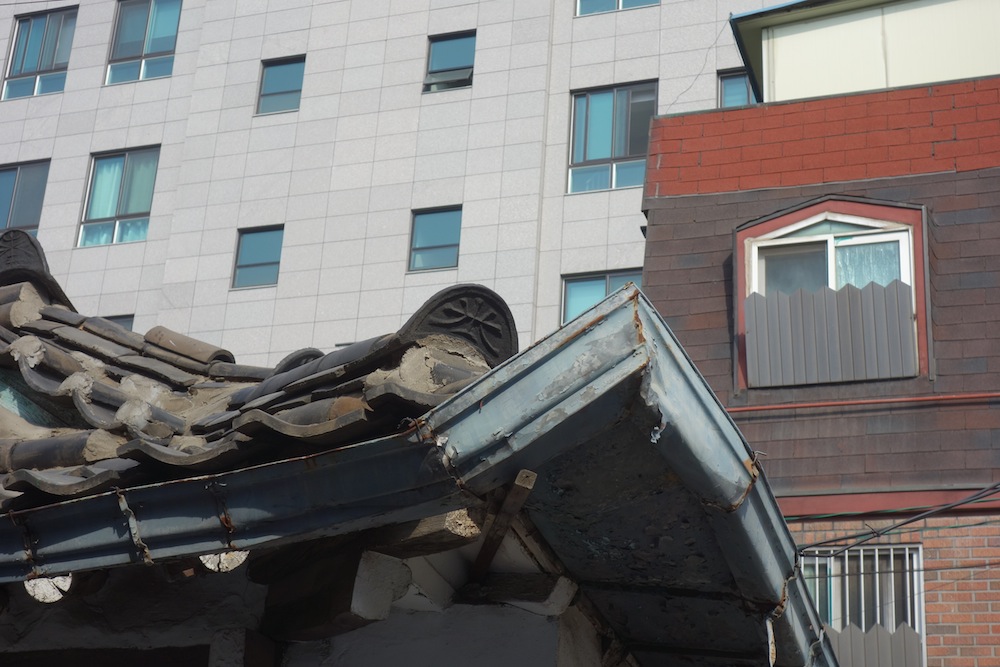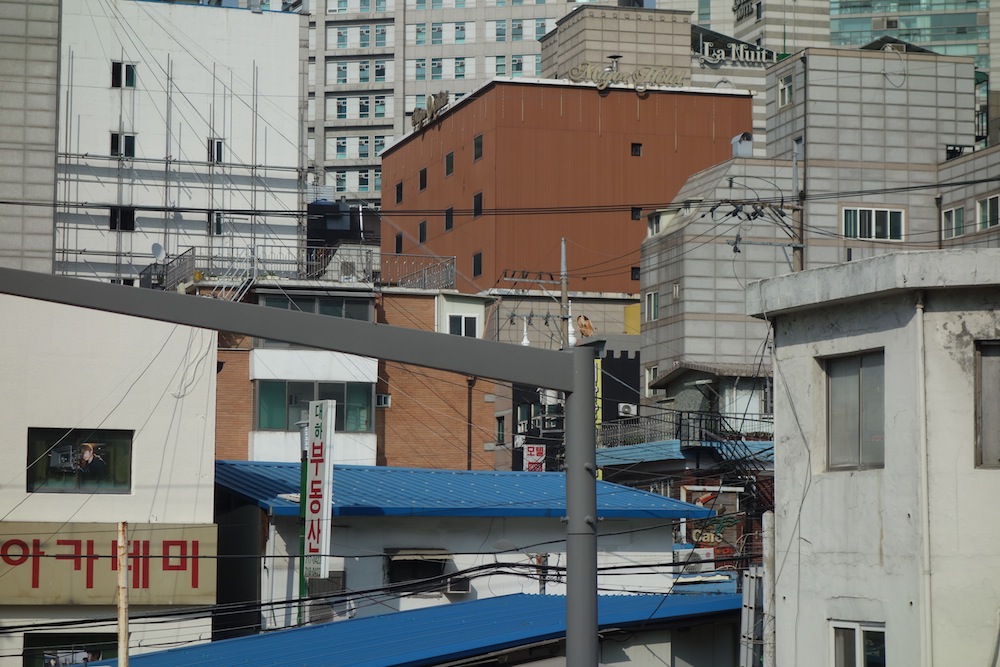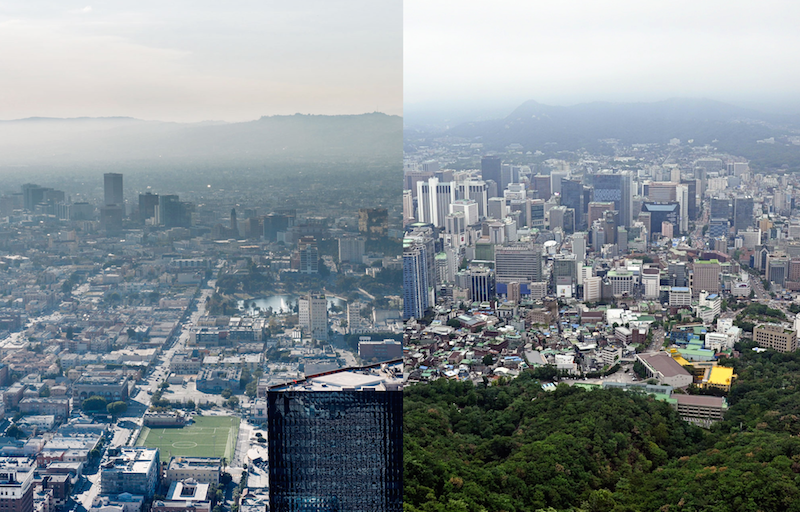Los Angeles and Seoul have in common enormous size and unusual structure, both of which make them difficult places to apprehend quickly, or indeed even slowly. Someone seeking a functional understanding of either one needs a “way in,” and so, when I first moved to Los Angeles early in this decade, I looked for it in books, reading all I could find about that city. When I then moved from Los Angeles to Seoul three or so years ago, I immediately began reading all I could find about this city. That in addition to the reading about Los Angeles I never stopped doing, my four years there having generated more questions than they answered. Still, my reading (and indeed writing) about Los Angeles and Seoul has revealed to me not just a great deal about the nature of each individual city, but something about their deeper, less obvious commonalities as well.

Over the past ten to fifteen years both Los Angeles and Seoul have entered new eras of self-awareness, and a greater quantity of writing about both cities (sometimes and sometimes not accompanied by quality) has resulted in that same period. In both cases some of that writing is straightforwardly celebratory, but at least as much of it strikes a pose of apology or defiance, as if these cities were inherently unworthy or even objectionable subjects. One of my favorite recent books about the Korean capital is called Even So, I Like Seoul (그래도 나는 서울이 좋다), and a good deal of the enthusiasm for Los Angeles currently expressed in text or any other medium could be similarly titled. Even the most avid enthusiasts of either city will make certain concessions right upfront — Seoul’s bad air and unruly drivers, Los Angeles’ sizable homeless population and incomplete transit infrastructure — and both seem to take as given one particular criticism of both cities so common as to be almost reflexive: that they’re ugly.

“Why is South Korea so ugly?” An e-mail with that subject line arrived in my inbox last week, not from someone wanting me to explain why personally, but from the question-and-answer site Quora, whose algorithm regularly connects its members with questions they might have the knowledge to answer. Much of the Korea-related curiosity expressed on Quora I couldn’t begin to address (“Who is better, BTS or EXO, in terms of everything?”), but the ugliness of the built environment here — or rather, the perceived ugliness of the built environment here — has been on my mind for quite a while. Claims about South Korea are usually about Seoul, which represents its country in a way no American city could, and Korean or non-Korean, even those who display a great enjoyment of Seoul in other respects will tear into its appearance without prompting, and with a glee that comes off as almost cathartic.

“Korea is dense,” says the question’s top respondent, a resident foreigner named Nik Trapani. “All the beauty is rarely far away from all the ruin that people bring to nature.” And in that “ruin” exists little one could call architecture deserving of the name: “Koreans demand modern so anything old loses value quickly, so not much is built with the distant future in mind.” Some of that comes out of the fact that “Korea is really a 60 year old country with millennia of history. Even in the aftermath of the second world war, Europe managed to keep or restore a good amount of its physical history. Its hard for many to imagine the scale of destruction that this country has recovered from. Not everything that was built out of necessity has been replaced.” And on top of that, “development has been uneven. Like most places, certain areas are prioritized for development by both the private and public sectors, while others are ignored.”

I don’t disagree with Trapani’s assessment, and I’ve often recommended to foreign visitors myself that they bear in mind that Korea’s history goes back 5,000 years in one sense but less than a century in another. (Seeing the country as attempting to connect itself directly to the West rather than the rest of Asia explains a thing or two as well.) “There are, of course, dozens of other reasons one might give Korea a once-over and think it’s a bit hard on the eyes,” Trapani adds, “but that says more about the depth of one’s experience in a place than the place itself.” I think more or less the same thing every time I find myself in an expat complaint session about all the identical high-rise apartment towers or how the neighborhood where they get out after an hour on the train looks exactly like the neighborhood where they got on: if you can only recognize the Starbucks locations, the fast-food joints, and the convenience stories, they’re all you’re going to see.

Poor understanding of the city is hardly an affliction limited to the foreigners living here: not only does the homegrown “Seoul bumpkin” assume everything outside the capital to be featureless countryside, he also lives in ignorance of most of everything inside the capital as well. Instead he looks to, sometimes visits, and occasionally writes books unfavorably comparing Seoul to higher-profile foreign capitals like Tokyo, New York, London, or Paris — the kinds of places called “real cities” by Los Angeles-ignorant Angelenos. “Every country has its ugly parts,” writes another Quora user, a Korean-American by the name of Joe Geun. “I grew up in L.A. and it is by far one of my favorite places to go to in the US but is L.A. a perfect city? Nope. Some parts make it look like a developing city.” Some parts of Seoul — albeit often parts considerably more appealing than the most developed and therefore blandest ones — surely do the same.

When Seoulites or Angelenos look enviously upon other distant and supposedly more beautiful cities, what exactly about those cities do they envy? Their complaints suggest that they see the Parises, Londons, New Yorks, and even Tokyos of the world as more deliberately crafted cities than the ones they live in. And though Seoul and Los Angeles never had their own Baron Haussmann or Christopher Wren, the widespread perception that they were built nearly at random has little basis. “According to folk wisdom, Los Angeles grew without a plan,” write David Gebhard and Robert Winter in their Architectural Guidebook to Los Angeles. “This is nonsense.” Gebhard and Winter also coined the evocative term “skulchpile” to describe the haphazard-looking commercial district built along Vermont Avenue in Los Feliz, but it doesn’t take too deep a look beneath the surface of that skulchpile, or any other in Los Angeles or Seoul, to comprehend the kind of order that gave rise to it.

Appreciating either Seoul or Los Angeles may well demand a certain amount of deliberately gathered knowledge and experience, but that idea can easily be taken too far. With my interest in Los Angeles only growing even here in Seoul, I keep an eye out for Los Angeles writing and Los Angeles movies but also an ear out for Los Angeles songs. The sentiment that Los Angeles might look bad but is revealed as non-bad to those who put their time in has taken a variety of musical forms, from 2Pac‘s exhortation to live, die and party to Randy Newman‘s ironic condemnation made to sound like ironic celebration. The Bird and the Bee’s latest album Recreational Love, which has been in my heavy rotation for months, has a song simply called “Los Angeles” that addresses the city itself: “Don’t listen to a thing they say / They don’t need you in the same way / Don’t ever let them change you / They don’t know you like I do.”

“Stop asking me where I come from,” goes the chorus. “I’m from L.A.” That line brings to mind another from Thom Andersen’s video essay Los Angeles Plays Itself, a formative “text” of my own view of the city. Calling Los Angeles by its initials, Andersen writes, originally functioned “as a slightly derisive diminutive. Now it’s become second nature, even to people who live here. Maybe we adopted it as a way of immunizing ourselves against the implicit scorn, but it still makes me cringe. Only a city with an inferiority complex would allow it.” Korea has often been described as laboring under an inferiority complex of its own, and its responses to the feelings of ugliness associated with that complex have included altering aspects of its capital to reflect an approximation of foreign conceptions of what a proper city should look like — an imperative familiar to anyone who knows Korea’s robust plastic surgery industry.

The response of many Angelenos, for their part, seems to have moved from postwar anxiety about whether Los Angeles possesses all the elements of a “world class” city to the concession that it may have plenty of room for improvement, but that it’s fine if you just get used to it, sticking to the good and ignoring the bad. A variously attributed observation, which Los Angeles Plays Itself credits to Roman Polanski, distills this kind of attitude: “There’s no more beautiful city in the world… provided it’s seen by night and from a distance.” From what I’ve found, this tradition goes back at least as far as the time when observers of the city’s postwar form began trying stick new labels on it, from “mega-region” to “constellation of villages” to such flat contradictions as “suburban city” and “polycentric city.” But at what point does description become complacency?

When, to be blunter, does insisting that others don’t “know” Los Angeles like you do start to sound like a woman insisting that others don’t “know” her abusive boyfriend like she does? The explanations for the deficiencies of Seoul — so much got destroyed in the war, there are a lot of people here, modern Koreans care about economics more than aesthetics — can also resemble excuses. But Seoulites, as much outward distaste as they might have for their city, regard it as always a work in progress, with any part of it subject to erasure and revision at a moment’s notice. Angelenos, at least as far as all my reading, viewing, and listening has suggested to me, used to feel the same way about their city. But when did they last feel it with real conviction? Maybe in the late 1960s, say, when nouvelle vague filmmaker Jacques Demy came to town to shoot Model Shop, the story of a young Los Angeles architect on the verge of being drafted into Vietnam.

In a passage quoted in Los Angeles Plays Itself, the film’s protagonist says this of Los Angeles:
I was driving down Sunset, and I turned on one of those roads that lead up into the hills, and I stopped at this place that overlooks the whole city. It was fantastic. I suddenly felt exhilarated. I was really moved by the geometry of the place, its conception, its baroque harmony. It’s a fabulous city. To think some people claim it’s an ugly city when it’s really pure poetry, it just kills me. I wanted to build something right then, create something.
The Los Angeles in which one could just “build something,” architecturally or otherwise, is now long gone, and the much more rigid Los Angeles of today could do well to learn from the example of Seoul, too aggressive and reckless though its constant efforts to develop and redevelop may sometimes seem. The glimpses I catch of Los Angeles from faraway — such as the footage of the city that loops all day long at a favorite Gangnam coffee shop of mine — continue to exhilarate me, but I think I speak from the same basic emotions as The Bird and the Bee when I say to Los Angeles, let them change you, please let them change you.
Related Korea Blog posts:
Why I Left Los Angeles for Seoul
Bitter, Sweet, Seoul: a Vivid Crowdsourced Portrait of an Unromanticized City
Looking Back at LA Arirang, the 1990s Korean Sitcom about Life in Los Angeles
Western Avenue: How Korean Cinema Portrayed the 1992 Los Angeles Riots
A Korean Travel Writer Reveals the Los Angeles Even Angelenos Don’t Know
Living the Vertical Life in Seoul
Based in Seoul, Colin Marshall hosts the Korean-language podcast 콜린의 한국 (Colin’s Korea) and is at work on a book called The Stateless City: a Walk through 21st-Century Los Angeles. You can follow him at his web site, on Twitter @colinmarshall, on Facebook, or on Instagram.


